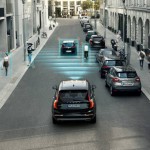 Driverless cars are becoming an increasing presence on our roads, with the Google cars alone having racked up over 1 million miles thus far.
Driverless cars are becoming an increasing presence on our roads, with the Google cars alone having racked up over 1 million miles thus far.
They continue to have challenges understanding what other road users might be about to do next however. I wrote earlier this year about a Cornell led project that is aiming to develop predictive capabilities.
The challenges of this were drawn into sharp focus recently with the news that the Google car had been involved in its first incident whereby it could shoulder part of the blame. When the (low speed) crash was analyzed, it emerged to be a lack of appreciation of the social nuances of communication that was its downfall.
Look into my eyes
The crash was caused by a misunderstanding between the Google car and a bus driver approaching in another lane over who would cede right of way to the other.
When humans drive, we tend to gage such sentiment from eye contact, although given the number of misunderstandings humans make, it underlines the challenges involved for machines to replicate this level of understanding.
“It has long been known that predictive eye movements play an important role in guiding our own actions,” Gustaf Gredebäck (Uppsala University) and Terje Falck-Ytter (Karolinska Institutet) write in Perspectives on Psychological Science. “A large body of work has shown that predictive eye movements are functionally integrated into most everyday actions that we perform, including reaching, walking, driving, playing sports, and cooking.”
“The idea was that when you see someone else act, you activate your own motor plans for similar actions, and these motor plans include instructions for the oculomotor system to implement goal-directed, predictive saccades,” the researchers continue.
Studies have shown that eye contact can be crucial in the exchange of information, particularly at the kind of speed required in a driving environment.
Of course, this does assume that driverless cars will be sharing a road with human drivers, and thus being able to read eye signals will be crucial to safe operation.
If driverless cars are only sharing a road with other driverless cars however, then this kind of information can be easily communicated instantly and electronically between the cars, although there will remain the need to be able to read and understand the intention of other road users, such as cyclists or pedestrians.
Predictive motoring
A German team at UR:BAN are working to build models of road users behavior to try and build these into how driverless cars will behave.
The project has already highlighted the challenges involved, as drivers were found to behave very differently when tired or stressed, or even when distracted by various electronic devices.
Being able to predict driver behavior therefore will be a hugely complex task. Driverless cars have already made huge strides, but you sense that this is their biggest challenge yet.